Nature's Time Capsule – Chucu Tablets
PRIMITIVE - Friday, March 13, 2015 |
|
By Misaki Imagawa
In 1950 Indonesia, the monsoon season was just beginning, drenching the island of Sulawesi with damp, humid air. Heavy clouds hung low over the tropical forest, obscuring the peaks of the nearby mountains. A small group of women were making their way through the lush forest, bearing baskets full of ripe fruits, and following doggedly on their heels was a young girl clutching a bright red mango. She turned it over and over in her little hands, so delighted with her find that she hardly noticed the forewarning of the darkening sky and the downpour to follow. As she rushed to keep up with the others, hurrying along the dirt path to avoid the rain, a rustling in the bushes distracted her. She stopped to investigate and noticed a family of palm civets, or toddy cats, spooked by the rolling thunder. When she looked up, panic sunk in – the adults were nowhere to be seen! She was all alone.
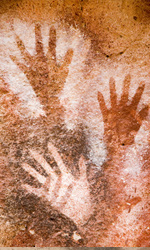 |
|
The girl ran as fast as she could, but soon lost her way amid the maze of paths. Just as the torrential rain started, she burst into a clearing at the base of a rocky outcropping and saw a cave opening where she could hide. As her eyes adjusted to the darkness, she wandered deeper into the cave, lured by curiosity. Outside, the rain ended as quickly as it had started and filtered light illuminated the walls inside. The girl’s eyes filled with wonder at what she saw. An image appeared before her; it was an animal painted in deep red on the wall of the cave. Beside it, numerous hand prints marked the wall. Stepping closer, she pressed her own palm against a print that was the same size as her hand. Little did the young girl know that half a century later, archeologists would discover this was the oldest cave painting ever created by humankind.
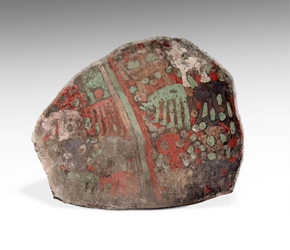 |
|
On a different continent at a different time, a similar discovery was taking place. In the hills of Arequipa, Peru, a group of scholars discovered caves that had heretofore been unexplored. Inside these underground chambers they found a pile of painted terracotta tablets. They appeared to have been ritually broken into rectangular and trapezoid shapes and were decorated on one side with paint. The paintings depicted four-legged animals and humans on top and around a series of dots, and were strangely reminiscent of ancient cave paintings. Scholars have pointed out the importance of the dots, speculating they depict rain. As Chucu was the local center for offerings to the ‘God of Water’ in pre-Columbian Peru, it is believed that the painted shards were offered in the hopes of receiving good rainfall for the crops and harvest. The tablets were created between 1300 - 1600 A.D.
Although there is much to be discovered about the people who painted the Chucu tablets, it is safe to say the artifacts themselves would not have been discovered if the caves had not protected them. Caves have provided us with invaluable information about human history through paintings and the preservation of artifacts, freezing in time what would otherwise have been lost forever.
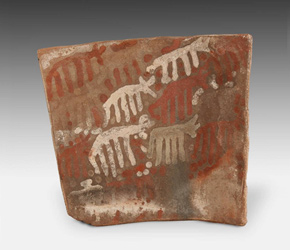 |
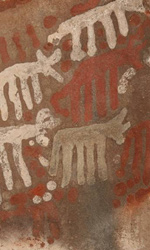 |
||
PRIMITIVE ID# A1000-009 |
|||
Many ancient artifacts have been excavated from caves all over the world where dry, constant atmospheres have helped prevent their deterioration over many millennia. In Mali, West Africa, there are caves high up in the sandstone cliffs that served as burial grounds for the Tellem people, situated there to avoid flash floods. Though the Dogon people have inhabited the land since the 14th century and practice the same custom, these older burial caves revealed artifacts that did not belong to Dogon customs. This clued archeologists to a wealth of new information about the indigenous Tellem people and their culture. Similarly, inside the Qumran Caves of the West Bank, nearly 1000 biblical scrolls dating back to roughly 400 B.C. were miraculously preserved. This provided scholars of many fields great insight into the past.
Before the discovery of the Sulawesi cave paintings, it was believed that the earliest cave art originated in Europe. The Chauvet Cave paintings in France date between 30,000 to 32,000 years ago; and perhaps the most well known are the paintings in the Lascaux Caves, dating from 15,000 to 17,000 years ago. However, recent studies of the cave paintings found in Sulawesi revealed them to be between 35,000 to 40,000 years old. This newfound information affirms artistic self-awareness and the abstract mind did not develop exclusively in Europe, but instead, simultaneously in various other parts of the world. Although researchers remain uncertain about the exact function of these paintings, they nonetheless have revealed much about the prehistoric peoples who created them.
From prehistoric times, caves have been used as resources for humankind, and unbeknownst to those who created the paintings, scrolls, artifacts and tablets found inside, their actions would subsequently connect our time to theirs. In this sense, caves have proven to be, and will continue to be, nature’s most powerful time capsules. Inside their stone walls, thousands of years of knowledge often lay waiting to be discovered. Sometimes, all it takes is the curiosity of a lost girl to unearth the secrets of the past.
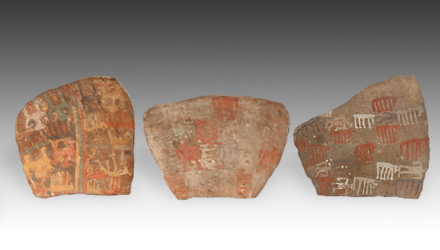 |
Download this Article: Nature's Time Capsule.pdf